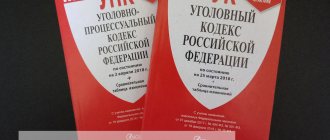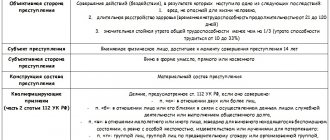Material checked by Expert: Ekaterina Sankina
Experienced lawyer, auto lawyer. Legal assistance in case of deprivation of a driver's license.
A traffic accident is a risk of injury.
According to data from the State Traffic Inspectorate published on the official website of the department, in 2021, 137,662 road accidents occurred in the Russian Federation, as a result of which 15,788 people died and 175,170 were injured.
Accident rates suggest the need to obtain theoretical knowledge and law enforcement practice on this issue.
If there is a person injured as a result of the accident, it is necessary to determine the severity of the injury caused. The culprit of the accident must compensate for the harm caused to the health of the victim. The severity of the punishment and the amount of compensation depends on how severe the injuries were.
Serious bodily injury in a road accident (Article 264 of the Criminal Code of the Russian Federation)
If an accident occurs and there is a victim, the culprit must be punished.
“The law is universal. The case that must be determined on the basis of the law is isolated. To bring the particular under the universal requires judgment.”
(Marx K., Engels F. Works, 2nd ed. T. I.S.66-67).
In some cases, we can also talk about criminal liability. Everything will depend on how seriously the person was injured. The fact is also taken into account whether the culprit committed the accident intentionally or not.
In some cases, a driver intentionally hits another person.
A driver may commit such a crime out of a desire to take revenge, harm, or eliminate a competitor or rival.
If, as a result of an accident, a person receives serious bodily injuries, which subsequently cause serious harm to health, and this was done purposefully, we will be talking about murder.
If we are dealing with such a situation, then liability arises in accordance with Section VII of the Criminal Code of the Russian Federation.
Article 264 of the Criminal Code of the Russian Federation provides for liability for violation of traffic rules and operation of vehicles.
The article has six subparagraphs. Each of them determines a different punishment depending on the presence of aggravating circumstances.
Aggravating circumstances in accordance with Article 264 of the Criminal Code of the Russian Federation include:
- detection of prohibited substances in the blood of the culprit - alcohol, narcotic and psychotropic substances;
- the driver fled the scene of the accident;
- death of the victim;
- More than two were injured as a result of the accident.
In cases where two or more people were injured as a result of a traffic accident, the actions of the person who violated the traffic rules while driving a vehicle are subject to qualification under that part of Article 264 of the Criminal Code of the Russian Federation, which provides for stricter liability for grave consequences caused by negligence . (Resolution of the Plenum of the Supreme Court of the Russian Federation dated December 9, 2008 N 25 (as amended on May 24, 2016) “On judicial practice in cases of crimes related to violation of traffic rules and operation of vehicles, as well as their unlawful taking without the purpose of theft" ).
The punishment and degree of responsibility of the perpetrator does not depend in any way on who was injured as a result of his actions - another driver or a pedestrian. The punishment is also determined by the set of traffic rules that the culprit violated through his actions.
Hit a pedestrian in a place not allowed for crossing or due to the pedestrian’s fault
In this case, everything becomes more complicated for the pedestrian in terms of liability, and the hit pedestrian still has legal rights. But, alas, responsibility will not be completely removed from the driver, even without his fault in the accident.
And, if everything is clear for a pedestrian: he violated traffic rules - pay for damage to the car, then what is the matter with the driver, why should he be punished without being guilty?!
The answer to this question is given by Article 1079 of the Civil Code of Russia. It is he who defines the vehicle as a vehicle of increased danger, and the driver as the owner of a source of increased danger (IPO). But most importantly, the Civil Code of the Russian Federation regulates that the operator of an IPO, regardless of guilt in an accident, must compensate for the damage caused by such a source.
There are two exceptions to this obligation in our case:
- when a pedestrian deliberately jumped under the wheels (and this still needs to be proven),
- when the collision occurred under the influence of force majeure.
Thus, the following drivers are recognized as owners of IPO:
- cars in a collision with pedestrians or cyclists,
- even bicycle drivers in accidents with pedestrians.
As a consequence of this established practice of legislation in 2021, we find that if a pedestrian is at fault in an accident involving a car and a pedestrian, then regardless of the outcome and consequences for both participants, the pedestrian pays for the restoration of the car, and the driver pays for the harm caused to the pedestrian (even in absence of the driver’s fault)… However, the damage to the pedestrian is paid for by the motorist’s insurance under MTPL, if he has valid insurance.
Most often, accidents involving a collision with a pedestrian due to the latter’s fault occur:
- on a country road,
- on long highways,
- in places of heavy pedestrian traffic, where some representatives of this category of road users are simply too lazy to reach the pedestrian crossing.
Another unpleasant surprise in the legislation of 2021 - if suddenly a driver hits a pedestrian and flees the scene of an accident when the pedestrian is at fault, then the owner of the car will be responsible, because Article 1079 of the Civil Code refers to the owners of vehicles as sources of IPO. Of course, this is provided that the escaped driver is not identified, and the car itself is known by license plates. But even in this case, the damage to the pedestrian is covered by the car owner’s compulsory motor liability insurance.
How is harm to health classified in a road accident?
There are several criteria for delimiting the severity of damage caused. Determining the specific degree depends on the loss of ability to work and the presence of a threat to life.
Easy
A detailed description of the mild severity of the injuries received is described in the addendum to Article 12.24 of the Code of Administrative Offenses of the Russian Federation.
A mild degree of severity of injury is understood to mean short-term loss of ability to work.
In order not to be mistaken, it is worth referring to the order of the Ministry of Health and Social Development of the Russian Federation dated April 24, 2008 N 194n “On approval of Medical criteria for determining the severity of harm caused to human health.”
This order states that receiving such injuries may result in hospitalization or outpatient treatment with sick leave for up to three weeks.
If the victim is not diagnosed with anything other than minor scratches and bruises, such injuries cannot be classified as even minor injuries. Consequently, no one will suffer any punishment in this case.
If a person still has minor injuries, the driver will be held administratively liable in accordance with Article 12.24 of the Code of Administrative Offenses of the Russian Federation. The driver faces a fine of 2,500 to 5,000 rubles. In some cases, the culprit of the accident may lose his license for up to one and a half years.
Average
Moderate severity is injuries that do not pose a threat to life or amount to a loss of ability to work of 10 to 30 percent inclusive, and the period of being on a certificate of incapacity for work is set at more than three weeks (more than 21 days). In this case, administrative liability also arises under Article 12.24. The culprit is subject to a fine of 10,000 - 25,000 rubles or deprivation of rights for a period of up to 24 months.
Heavy
If the resulting injuries are classified as causing grievous bodily harm, then we are talking about criminal liability. Such damage refers to injuries that pose a threat to the life of the victim. To classify such injuries, a forensic medical examination is ordered.
Fatal
If the victim dies at the scene of the accident or after some time in the hospital, a criminal case is opened and the connection between the injuries resulting from the accident and the death is determined. A driver who causes a fatal accident may well receive a real prison sentence.
Hit a pedestrian at a crossing, sidewalk or on a turn, the driver is to blame - fines and deprivation of license
The most common and, perhaps, deplorable situation for motorists is a collision with a pedestrian in a zebra crossing zone. In this case, the pedestrian road user is right, and the driver is guilty in almost all cases. In this case, the driver is charged with violating the following points:
- 14.1 Traffic rules, if the collision occurred at an unregulated pedestrian crossing,
- 14.2 of the Rules, if the collision occurred in a zebra crossing zone regulated by a traffic light,
- in addition to one of the above, they may be charged with 10.1 traffic rules - a “universal” clause that fits many situations, requiring you to choose a speed in order to anticipate the danger and avoid it.
The penalties in this case depend on a large number of factors. Let's list them all.
If the pedestrian escaped with fright, but there was no collision
Then the driver is entitled to one single punishment - a fine of 1.5 to 2.5 thousand rubles under Article 12.18 of the Code of Administrative Offenses for not allowing a pedestrian to pass at the crossing. This fine can also be issued on camera and is applied for failure to give way to pedestrian road users.
Criteria for causing serious harm to health in an accident
Some criteria for causing grievous bodily harm as a result of an accident are prescribed in Article 111 of the Criminal Code. The article states that grievous bodily harm includes:
- Abortion.
- Receiving severe mental trauma.
- Loss of vision or hearing.
- Loss of any organ or limb.
- Cosmetic facial defects.
- Major blood loss.
- Ruptures of main and large vessels.
- Acute renal, liver, or heart failure.
This is not a complete list of serious bodily injuries, but only the main part of them.
What is the penalty for an accident involving serious bodily injury?
If such injuries are caused by negligence and the driver was not under the influence of alcohol or drugs at the time of the accident, he faces a prison sentence of up to two years. If the court proves the presence of malicious intent or deliberate infliction of harm, the term of imprisonment may increase to 10 years.
Punishment in such cases is imposed by the court in accordance with Article 264 of the Criminal Code. In this case, judges may impose a suspended sentence instead of a real one.
According to statistics, there are many examples when a case can be completely closed due to the reconciliation of the parties and a peaceful resolution of the conflict.
Is it possible to avoid punishment in 2021 and how?
Yes, of course you can. The same as when applying any other punishment. The whole point is that in order to hold a person accountable, a number of factors and circumstances must coincide. If one of them is missing, then the person cannot be attracted. In addition, there are factors that, at the discretion of the court, may help avoid punishment.
However, a full and comprehensive consideration of all such circumstances may require several new articles, since avoiding responsibility is a very important issue that should be studied in as much detail as possible. Moreover, you will definitely need a lawyer for this.
However, let us list the main circumstances.
Minority
The most accurate and specific factor contributing to the ability to avoid criminal liability 100% is age. If a person at the time of attraction has not reached 16 years of age, if he is attracted under articles 264, 264.1 or 268 of those discussed by us, then he cannot be punished. As for intentional harm, under Articles 105, 111 and 112 the age is reduced to 14 years. This is stated in Article 20 of the Criminal Code of the Russian Federation.
Reconciliation of the parties
Another opportunity to avoid criminal punishment is the reconciliation of the culprit of the accident with the victims or the closest relatives of the deceased as a result of his guilty actions. However, such reconciliation does not in all cases provide the possibility of release from liability.
To do this, the following conditions must be met:
- the consequences of an accident must be of minor or moderate severity,
- in fact, the parties must reconcile, which must either be reflected on paper or agreed upon by the parties in front of the judge in the courtroom,
- the culprit must compensate (make amends for the harm caused).
These factors are listed in the relevant Article 76 of the Criminal Code of the Russian Federation.
Regarding the first point, then
- minor crimes include those whose punishment carries no more than 3 years of imprisonment,
- to the average - imprisonment of up to 5 years for intentional crimes and up to 10 years for careless ones.
Thus, it is possible to avoid criminal liability in connection with the reconciliation of the parties under all articles of the Criminal Code for road accidents, except for those related to the death of a person: premeditated murder (Article 105) and causing death under Article 264 parts 4 and 6 while intoxicated.
If the victim or deceased is to blame
Another important factor is a mitigating one and therefore, together with the reconciliation of the parties, for example, can increase the chances that you will not be subject to criminal punishment (or at least mitigate it).
The point is that, in addition to the obvious guilt of the culprit driver, the violation was also committed by the victim or those killed in the accident. For example, a pedestrian violated the rules for crossing the road at a pedestrian crossing.
Paragraph 10 of the Resolution of the Plenum of the Supreme Court states that in this case this is a mitigating factor for the crime. However, the exception to this rule is passengers in the same car that the culprit was driving.
What can mitigate or increase guilt?
There are many factors that can be both mitigating and aggravating.
Softening:
- The culprit has not previously been brought to administrative or criminal liability.
- The culprit was a woman who is pregnant or is the mother of minor children.
- The driver did not try to escape from the scene and provided assistance to the victim in every possible way.
- Confession, cooperation with the investigation.
- The culprit does not refuse to compensate for the damage caused to health, as well as moral damage.
This is not a complete list of mitigating circumstances, but only the most common of them.
Aggravating:
- The culprit fled the scene.
- The culprit was under the influence of alcohol or drugs.
- The driver had previously been brought to administrative or criminal liability.
How moral and material damage is compensated
In accordance with current legislation, bringing to administrative or criminal liability is not a reason for evading compensation for moral or material damage.
According to Article 1064 of the Civil Code of the Russian Federation, harm caused to the person or property of a citizen, as well as harm caused to the property of a legal entity, is subject to compensation in full by the person who caused the harm.
The person who caused the harm is released from compensation for harm if he proves that the harm was not caused through his fault. The law may provide for compensation for harm even in the absence of the fault of the harm-doer.
Amount of insurance payment under compulsory motor liability insurance in connection with damage to life and health:
- in the amount of 500,000 rubles, if a fatal accident occurred, the victim received the first group of disability;
- 350,000 rubles if the victim received the second group of disability as a result of injuries received during the accident;
- 250,000 rubles when registering a disability of the third group.
The decisive factor here is the availability of valid insurance. It is clear that insurance does not always cover the amount of compensation. The maximum amount of insurance payments for the restoration of damaged vehicles is 400,000 rubles.
Moral injury
The amount of compensation for moral damage is determined by the interested party depending on the nature of the injuries received. Not only the injured persons, but also their close relatives have the right to receive compensation. If a criminal case is underway against the culprit, a civil lawsuit must be filed to obtain compensation for moral damages.
Material damage
The amount of financial compensation depends on the nature of the damage and has a specific amount prescribed by law.
If the culprit died, who will be held accountable?
Nobody!
Here you need to understand that the Criminal (and Administrative Code too) works to prevent subsequent crimes and correct the convicted person. And if the convicted person is not alive, then who should correct himself?!
Therefore, no one under any circumstances can bring the innocent relatives of a convicted person to criminal responsibility. Thus, part 1 of Article 43 indicates that punishment applies only to a person found guilty of a crime.
Thus, if both innocent persons and the culprit himself died in an accident, then there will be no one to hold accountable.
Serious bodily harm in an accident - judicial practice
If we analyze judicial practice, it can be noted that in the absence of aggravating circumstances, courts can be loyal to those responsible for an accident. A real sentence is rarely assigned; more often it is limited to a suspended sentence. Revocation of a driver's license for a maximum period of three years is also extremely rare.
Reconciliation of the parties and termination of the criminal case
If we take into account the experience of judicial practice, then upon reconciliation of the parties, the criminal case will be immediately dismissed. This is the most optimal solution to the current situation. It is possible if the culprit provides assistance to the victim and does not refuse compensation for moral and material damage.
Punishment if the driver is drunk
When reaching a verdict, the presence of aggravating circumstances plays a decisive role.
Examples from judicial practice:
The driver, while intoxicated, hit a pedestrian who was crossing the street at an unregulated pedestrian crossing. The driver had previously been repeatedly brought to administrative responsibility for speeding. The court, taking into account all the available evidence, imposed a sentence of imprisonment for a period of 2.5 years.
Bodily injury and leaving the scene of an accident
The driver lost control and crashed into the dividing fence. In this case, the passenger received serious injuries. The person responsible for the accident did not provide assistance to the victim and fled the scene. As a result, the court imposed a sentence of imprisonment for a period of three years.
Death of a passenger
A driver hit a pedestrian at an unregulated pedestrian crossing. As a result of his injuries, the victim died. The culprit fully admitted his guilt. He did not hide from the scene, he called an ambulance himself. He did not refuse compensation for moral damage to his relatives. The court took into account all mitigating circumstances and imposed a sentence of suspended imprisonment for a period of 2.5 years. For the same period of time, the person responsible for the accident will be deprived of his driver's license.
Replacing imprisonment with a court fine
The driver, having lost control of the vehicle, drove through a red light at high speed and collided with a car. The passenger in the vehicle that was involved in the collision died from his injuries. During the trial, the investigator petitioned to terminate the prosecution and impose a fine. Taking into account the pregnancy of the culprit of the accident and the absence of traffic violations in the past, the court imposed a fine of 200,000 rubles.
If a driver causes an accident, he may well avoid real punishment in the absence of aggravating circumstances. If the driver does not deny guilt, cooperates with the investigation in every possible way, and also compensates for moral and material harm to the victim, he may get away with a fine or deprivation of his license.
Can the traffic police confiscate a car?
No.
Confiscation of a criminal's property is a separate procedure clearly described by law. It is also described in what cases such property can be confiscated. And these cases are listed in Article 104.1 of the Criminal Code of the Russian Federation. There are no articles 264, 264.1 and others listed in our material, which are the basis for this.
In addition, even in order to compensate for damage to victims, they cannot confiscate a car within the meaning of Article 104.3 of the Criminal Code. However, keep in mind that in the case of a civil case for compensation of a particular damage, if there is nothing to take from the culprit in a simple way, then the car can be taken away and sold in order to compensate for the damage. But this is done purely by court decision and by bailiffs.







